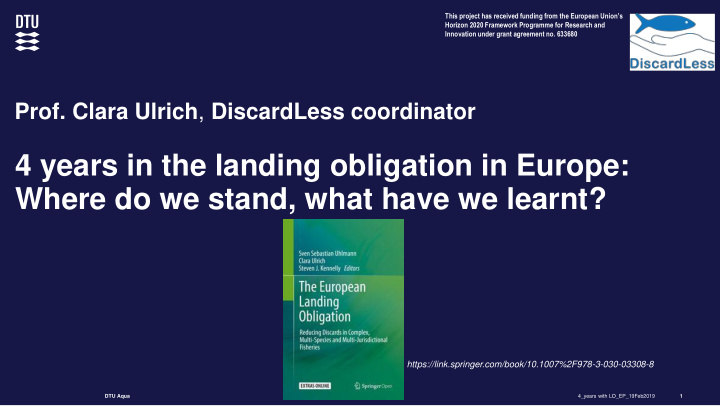



This project has received funding from the European Union’s Horizon 2020 Framework Programme for Research and Innovation under grant agreement no. 633680 Prof. Clara Ulrich , DiscardLess coordinator 4 years in the landing obligation in Europe: Where do we stand, what have we learnt? https://link.springer.com/book/10.1007%2F978-3-030-03308-8 DTU Aqua 4_years with LO_EP_19Feb2019 1
Where did we stand at the end of 2018? Progresses on the regulatory side / regionalisation …. • 19 Regional Discard Plans adopted since 2014, laying down the calendar of implementation (species*fisheries) and the exemptions (high survivability, de minimis) Percentage of TACs partially or fully subject to the LO by sea basin and year • Scientific foundations for evaluation of discard plans and implementation progresses (ICES, STECF) : exemptions, monitoring of undersize landings, member states reporting • Changes in the control operations (“Last Haul” Eur. Fisheries Control Agency) STECF PLEN 18-01, SWD/2018/329 DTU Aqua Europa Parliament 19/02/2019 2
Where did we stand at the end of 2018? • Progresses on reaching common understandings on discard causes and choke species …. Choke categories: • Category 1: Sufficient quota at Member State level, but poorly distributed within a country issue at PO/individual level • Category 2: Sufficient quota at EU level but insufficient at Member State level, Worst in NWW relative stability issue (STECF 18-02) • Category 3: Insufficient quota at EU level, overfished stock 10 stocks • high risk • Category 4: Economic choking. 17 stocks • moderate risk Choke situations not really observed yet! Only speculations on what may happen if the NSAC 2017 landing obligation is fully enforced!! DTU Aqua Europa Parliament 19/02/2019 3
Which positive aspects of the LO? • DiscardLess conference Table Discussions 30/01/2019 • Awareness and dialogue • Collaboration with scientists / authorities • Mindset shift and new eyes on old issues • Can improve the reputation of the sector • Level playing field • Aiming at reducing discards make sense … • …. DTU Aqua Europa Parliament 19/02/2019 4
Where did we stand at the end of 2018? But But VERY VERY LIT LITTLE TLE vis visible ible progresses so far…. Reported / Landed discards very low No obvious changes in selectivity/behaviour Very little use of EU operational funding (EMFF) allocated to landing obligation Still strong reluctance of the fishing industry Control and implementation very low But also… TAC increases (“top - ups”) but discarding continues… Removal of TACs… Changes to prohibited species (dogfish)… MultiAnnual plans with Fmsy upper… Reduction in the number of stocks with MSY advice … STECF PLEN 18-01, SWD/2018/329 Bycatch TACs on zero- catch advice… Borges et al., 2018 10.5281/zenodo.1238588 DTU Aqua Europa Parliament 19/02/2019 5
The landing obligation dilemma Constraints needed to Flexibility needed incentivise to keep fishing changes Different approaches in different Member States DTU Aqua Europa Parliament 19/02/2019 6
STECF 2018 Assessment of whether Member States did report significantly more steps towards the implementation of the landing Obligation in 2017 compared to 2016 Member States not listed did not report to EU for 2017 STECF PLEN 18-01 Table 5.2.2 page 38 DTU Aqua Europa Parliament 19/02/2019 7
Which consequences? DTU Aqua Europa Parliament 19/02/2019 8
Which consequences for fisheries data? • Discrepancies between discards estimates • Fisheries observers less accepted onboard • Potential bias (changes in behaviour when they are onboard) • Knowlegde on discard volumes more uncertain unwanted catch 2017 (ICES) What’s the catch??? L - Landings B – Below MCRS (BMS) haddock plaice cod cod plaice sole North Sea W Baltic D – Observed Discards W Baltic E Baltic E Baltic North Sea Skagerrak Kattegat R – Reported Discards DTU Aqua Europa Parliament 19/02/2019 9
Which consequences for the scientific advice? • Data more complex Increased uncertainty in the stock assessments • Data more uncertain • The ” Unwanted Catch ” schizophrenia! The Discards-who-cannot-be- named • STECF Data cannot be made public anymore! • ICES ” Catch advice ” is much more difficult to formulate and understand • The exemptions and uplifts are not easily monitored/accounted for in the advice Rihan et al. 2019 DTU Aqua Europa Parliament 19/02/2019 10
Which consequences for the TACs? TACs under LO > TACs with discards 140 50 45 45 120 Average tonnage increase (%) 40 100 35 31 30 Number of TACs 28 30 80 23 25 60 20 15 40 10 20 5 0 0 2015 2016 2017 2018 2019 DTU Aqua Europa Parliament 19/02/2019 11
Which consequences for MSY? • Risk of Increasing fishing mortality!! • STECF CFP Monitoring: The positive trends from pre CFP reform are reversing https://stecf.jrc.ec.europa.eu/reports/cfp-monitoring DTU Aqua Europa Parliament 19/02/2019 12
Summary – 4 years on with the Landing Obligation • A lot has happened – and yet nothing has happened (not even the doomsday profety )… • The landing obligation has triggered an intense dynamic of dialogue and awareness that wouldn’t have taken place otherwise • The LO has remained very unpopular in the fishing industry. Its objectives remain unclear and little supported by the national administrations • The obligation to bring to land is more controversial than the obligation to reduce (and register) discards • Control and enforcement are absolutely unsufficient. The current procedures cannot control the LO effectively. But new cost-efficient tools are available (EM, genetics..) • TACs have been increased but discarding continue. This goes against the MSY objectives • There are too many regulatory constraints and contradictions, which complicate further the implementation DTU Aqua Europa Parliament 19/02/2019 13
Looking ahead … • Everything starts now!! 2019 is key milestone year • Transition to results-based management… Control and monitoring is primordial! • TRANSPARENCY AND ACCOUNTABILITY of ALL CATCHES vs. FLEXIBILITY DTU Aqua Europa Parliament 19/02/2019 14
Recommend
More recommend